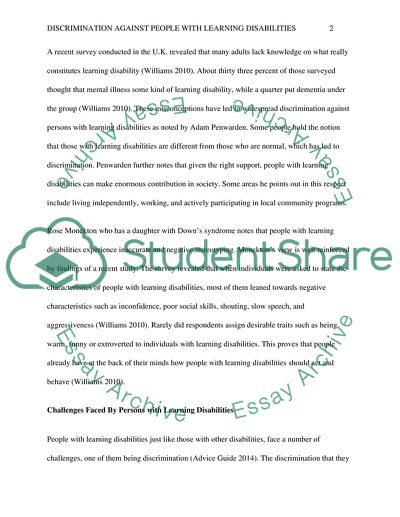Cite this document
(Challenges Faced by People with Learning Disabilities Term Paper, n.d.)
Challenges Faced by People with Learning Disabilities Term Paper. Retrieved from https://studentshare.org/social-science/1827837-ain-what-ways-do-people-who-use-adult-services-which-have-learning-disabilities-experience-discrimination-and-disadvantage-bwhat-contribution-can-social-work-make-to-ameliorate-the-impact-of-discrimination-and-disadvantage-that-people-with-learning
Challenges Faced by People with Learning Disabilities Term Paper. Retrieved from https://studentshare.org/social-science/1827837-ain-what-ways-do-people-who-use-adult-services-which-have-learning-disabilities-experience-discrimination-and-disadvantage-bwhat-contribution-can-social-work-make-to-ameliorate-the-impact-of-discrimination-and-disadvantage-that-people-with-learning
(Challenges Faced by People With Learning Disabilities Term Paper)
Challenges Faced by People With Learning Disabilities Term Paper. https://studentshare.org/social-science/1827837-ain-what-ways-do-people-who-use-adult-services-which-have-learning-disabilities-experience-discrimination-and-disadvantage-bwhat-contribution-can-social-work-make-to-ameliorate-the-impact-of-discrimination-and-disadvantage-that-people-with-learning.
Challenges Faced by People With Learning Disabilities Term Paper. https://studentshare.org/social-science/1827837-ain-what-ways-do-people-who-use-adult-services-which-have-learning-disabilities-experience-discrimination-and-disadvantage-bwhat-contribution-can-social-work-make-to-ameliorate-the-impact-of-discrimination-and-disadvantage-that-people-with-learning.
“Challenges Faced by People With Learning Disabilities Term Paper”, n.d. https://studentshare.org/social-science/1827837-ain-what-ways-do-people-who-use-adult-services-which-have-learning-disabilities-experience-discrimination-and-disadvantage-bwhat-contribution-can-social-work-make-to-ameliorate-the-impact-of-discrimination-and-disadvantage-that-people-with-learning.


